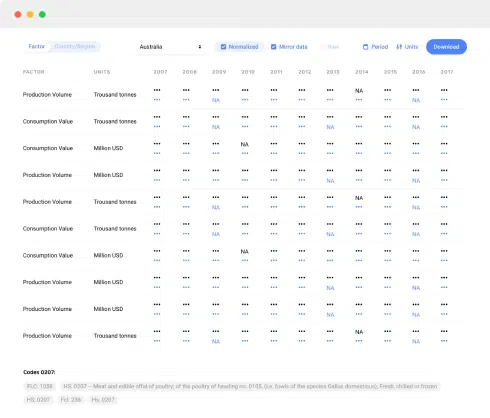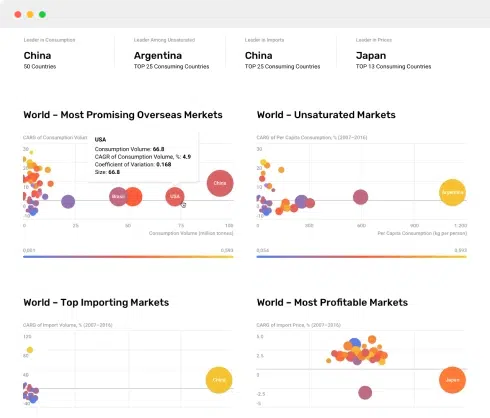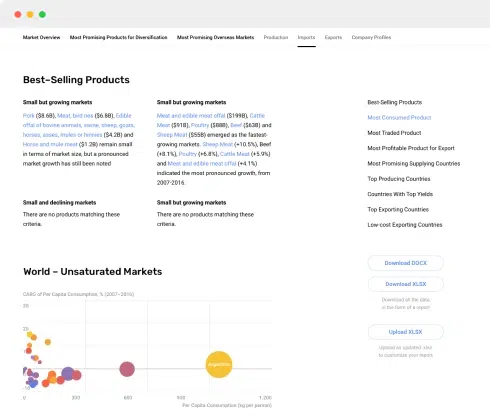
Africa - Saccharin and Its Salts - Market Analysis, Forecast, Size, Trends and Insights
Get instant access to more than 2 million reports, dashboards, and datasets on the IndexBox Platform.
View PricingAfrica: Saccharin Market 2025
Saccharin Market Size in Africa
The African saccharin market shrank to $X in 2021, with a decrease of -12.7% against the previous year. The market value increased at an average annual rate of +1.6% over the period from 2012 to 2021; however, the trend pattern indicated some noticeable fluctuations being recorded in certain years. Over the period under review, the market attained the peak level at $X in 2020, and then contracted in the following year.
Saccharin Production in Africa
In value terms, saccharin production contracted modestly to $X in 2021 estimated in export price. In general, production, however, saw a noticeable contraction. The pace of growth appeared the most rapid in 2014 when the production volume increased by 31% against the previous year. The level of production peaked at $X in 2015; however, from 2016 to 2021, production stood at a somewhat lower figure.
Saccharin Exports
Exports in Africa
In 2021, saccharin exports in Africa declined to X tons, with a decrease of -12.5% on 2020. In general, exports, however, showed strong growth. The growth pace was the most rapid in 2015 with an increase of 87%. The volume of export peaked at X tons in 2018; however, from 2019 to 2021, the exports remained at a lower figure.
In value terms, saccharin exports declined to $X in 2021. Over the period under review, exports showed a relatively flat trend pattern. The pace of growth was the most pronounced in 2015 when exports increased by 67% against the previous year. Over the period under review, the exports hit record highs at $X in 2018; however, from 2019 to 2021, the exports remained at a lower figure.
Exports by Country
South Africa represented the key exporter of saccharin and its salts in Africa, with the volume of exports amounting to X tons, which was near 74% of total exports in 2021. It was distantly followed by Uganda (X tons), committing a 22% share of total exports. Swaziland (X tons) followed a long way behind the leaders.
From 2012 to 2021, average annual rates of growth with regard to saccharin exports from South Africa stood at +7.1%. At the same time, Uganda (+13.8%) displayed positive paces of growth. Moreover, Uganda emerged as the fastest-growing exporter exported in Africa, with a CAGR of +13.8% from 2012-2021. By contrast, Swaziland (-8.2%) illustrated a downward trend over the same period. While the share of Uganda (+9.5 p.p.) increased significantly in terms of the total exports from 2012-2021, the share of Swaziland (-8.2 p.p.) displayed negative dynamics. The shares of the other countries remained relatively stable throughout the analyzed period.
In value terms, South Africa ($X) remains the largest saccharin supplier in Africa, comprising 73% of total exports. The second position in the ranking was held by Uganda ($X), with a 20% share of total exports.
From 2012 to 2021, the average annual rate of growth in terms of value in South Africa totaled -1.4%. The remaining exporting countries recorded the following average annual rates of exports growth: Uganda (+37.1% per year) and Swaziland (-11.1% per year).
Export Prices by Country
The export price in Africa stood at $X per ton in 2021, approximately equating the previous year. Overall, the export price, however, recorded a deep reduction. The pace of growth was the most pronounced in 2016 an increase of 27%. The level of export peaked at $X per ton in 2012; however, from 2013 to 2021, the export prices failed to regain momentum.
Prices varied noticeably by country of origin: amid the top suppliers, the country with the highest price was Swaziland ($X per ton), while Uganda ($X per ton) was amongst the lowest.
From 2012 to 2021, the most notable rate of growth in terms of prices was attained by Uganda (+20.5%), while the other leaders experienced a decline in the export price figures.
Saccharin Imports
Imports in Africa
In 2021, approx. X tons of saccharin and its salts were imported in Africa; dropping by -20% against 2020 figures. In general, imports, however, showed a relatively flat trend pattern. The most prominent rate of growth was recorded in 2016 with an increase of 40%. The volume of import peaked at X tons in 2020, and then contracted significantly in the following year.
In value terms, saccharin imports reduced to $X in 2021. Total imports indicated a perceptible increase from 2012 to 2021: its value increased at an average annual rate of +2.3% over the last nine years. The trend pattern, however, indicated some noticeable fluctuations being recorded throughout the analyzed period. Based on 2021 figures, imports increased by +18.6% against 2019 indices. The most prominent rate of growth was recorded in 2016 with an increase of 51% against the previous year. As a result, imports reached the peak of $X. From 2017 to 2021, the growth of imports remained at a lower figure.
Imports by Country
In 2021, South Africa (X tons), distantly followed by Nigeria (X tons), Swaziland (X tons) and Egypt (X tons) represented the main importers of saccharin and its salts, together committing 69% of total imports. The following importers - Kenya (X tons), Zambia (X tons), Tanzania (X tons), Algeria (X tons), Ghana (X tons), Malawi (X tons) and Zimbabwe (X tons) - together made up 23% of total imports.
From 2012 to 2021, the most notable rate of growth in terms of purchases, amongst the leading importing countries, was attained by Malawi (with a CAGR of +35.8%), while imports for the other leaders experienced more modest paces of growth.
In value terms, South Africa ($X) constitutes the largest market for imported saccharin and its salts in Africa, comprising 33% of total imports. The second position in the ranking was held by Nigeria ($X), with an 11% share of total imports. It was followed by Swaziland, with a 10% share.
From 2012 to 2021, the average annual growth rate of value in South Africa totaled +1.8%. In the other countries, the average annual rates were as follows: Nigeria (+10.6% per year) and Swaziland (+27.9% per year).
Import Prices by Country
In 2021, the import price in Africa amounted to $X per ton, with an increase of 9.6% against the previous year. Over the last nine years, it increased at an average annual rate of +1.7%. The most prominent rate of growth was recorded in 2014 when the import price increased by 14% against the previous year. Over the period under review, import prices attained the peak figure at $X per ton in 2016; however, from 2017 to 2021, import prices remained at a lower figure.
Prices varied noticeably by country of destination: amid the top importers, the country with the highest price was Algeria ($X per ton), while Nigeria ($X per ton) was amongst the lowest.
From 2012 to 2021, the most notable rate of growth in terms of prices was attained by Algeria (+7.6%), while the other leaders experienced more modest paces of growth.
Source: IndexBox Platform
Frequently Asked Questions (FAQ) :
This report provides an in-depth analysis of the saccharin market in Africa. Within it, you will discover the latest data on market trends and opportunities by country, consumption, production and price developments, as well as the global trade (imports and exports). The forecast exhibits the market prospects through 2030.
Product coverage:
- Prodcom 20144320 - Saccharin and its salts
Country coverage:
- Algeria
- Angola
- Benin
- Botswana
- Burkina Faso
- Burundi
- Cabo Verde
- Cameroon
- Central African Republic
- Chad
- Comoros
- Congo
- Democratic Republic of the Congo
- Djibouti
- Egypt
- Equatorial Guinea
- Eritrea
- Ethiopia
- Gabon
- Gambia
- Ghana
- Guinea
- Guinea-Bissau
- Kenya
- Lesotho
- Liberia
- Libya
- Madagascar
- Malawi
- Mali
- Mauritania
- Mauritius
- Mayotte
- Morocco
- Mozambique
- Namibia
- Niger
- Nigeria
- Reunion
- Rwanda
- Saint Helena, Ascension and Tristan da Cunha
- Sao Tome and Principe
- Senegal
- Seychelles
- Sierra Leone
- Somalia
- South Africa
- Sudan
- Swaziland
- Tanzania
- Togo
- Tunisia
- Uganda
- Zambia
- Zimbabwe
- Cote d'Ivoire
- Western Sahara
- South Sudan
Data coverage:
- Market volume and value
- Per Capita consumption
- Forecast of the market dynamics in the medium term
- Production in Africa, split by region and country
- Trade (exports and imports) in Africa
- Export and import prices
- Market trends, drivers and restraints
- Key market players and their profiles
Reasons to buy this report:
- Take advantage of the latest data
- Find deeper insights into current market developments
- Discover vital success factors affecting the market
This report is designed for manufacturers, distributors, importers, and wholesalers, as well as for investors, consultants and advisors.
In this report, you can find information that helps you to make informed decisions on the following issues:
- How to diversify your business and benefit from new market opportunities
- How to load your idle production capacity
- How to boost your sales on overseas markets
- How to increase your profit margins
- How to make your supply chain more sustainable
- How to reduce your production and supply chain costs
- How to outsource production to other countries
- How to prepare your business for global expansion
While doing this research, we combine the accumulated expertise of our analysts and the capabilities of artificial intelligence. The AI-based platform, developed by our data scientists, constitutes the key working tool for business analysts, empowering them to discover deep insights and ideas from the marketing data.
1. INTRODUCTION
Making Data-Driven Decisions to Grow Your Business
- REPORT DESCRIPTION
- RESEARCH METHODOLOGY AND THE AI PLATFORM
- DATA-DRIVEN DECISIONS FOR YOUR BUSINESS
- GLOSSARY AND SPECIFIC TERMS
2. EXECUTIVE SUMMARY
A Quick Overview of Market Performance
- KEY FINDINGS
- MARKET TRENDS This Chapter is Available Only for the Professional EditionPRO
3. MARKET OVERVIEW
Understanding the Current State of The Market and its Prospects
- MARKET SIZE: HISTORICAL DATA (2012–2024) AND FORECAST (2025–2035)
- CONSUMPTION BY COUNTRY: HISTORICAL DATA (2012–2024) AND FORECAST (2025–2035)
- MARKET FORECAST TO 2035
4. MOST PROMISING PRODUCTS FOR DIVERSIFICATION
Finding New Products to Diversify Your Business
- TOP PRODUCTS TO DIVERSIFY YOUR BUSINESS
- BEST-SELLING PRODUCTS
- MOST CONSUMED PRODUCTS
- MOST TRADED PRODUCTS
- MOST PROFITABLE PRODUCTS FOR EXPORT
5. MOST PROMISING SUPPLYING COUNTRIES
Choosing the Best Countries to Establish Your Sustainable Supply Chain
- TOP COUNTRIES TO SOURCE YOUR PRODUCT
- TOP PRODUCING COUNTRIES
- TOP EXPORTING COUNTRIES
- LOW-COST EXPORTING COUNTRIES
6. MOST PROMISING OVERSEAS MARKETS
Choosing the Best Countries to Boost Your Export
- TOP OVERSEAS MARKETS FOR EXPORTING YOUR PRODUCT
- TOP CONSUMING MARKETS
- UNSATURATED MARKETS
- TOP IMPORTING MARKETS
- MOST PROFITABLE MARKETS
7. PRODUCTION
The Latest Trends and Insights into The Industry
- PRODUCTION VOLUME AND VALUE: HISTORICAL DATA (2012–2024) AND FORECAST (2025–2035)
- PRODUCTION BY COUNTRY: HISTORICAL DATA (2012–2024) AND FORECAST (2025–2035)
8. IMPORTS
The Largest Import Supplying Countries
- IMPORTS: HISTORICAL DATA (2012–2024) AND FORECAST (2025–2035)
- IMPORTS BY COUNTRY: HISTORICAL DATA (2012–2024) AND FORECAST (2025–2035)
- IMPORT PRICES BY COUNTRY: HISTORICAL DATA (2012–2024) AND FORECAST (2025–2035)
9. EXPORTS
The Largest Destinations for Exports
- EXPORTS: HISTORICAL DATA (2012–2024) AND FORECAST (2025–2035)
- EXPORTS BY COUNTRY: HISTORICAL DATA (2012–2024) AND FORECAST (2025–2035)
- EXPORT PRICES BY COUNTRY: HISTORICAL DATA (2012–2024) AND FORECAST (2025–2035)
10. PROFILES OF MAJOR PRODUCERS
The Largest Producers on The Market and Their Profiles
-
11. COUNTRY PROFILES
The Largest Markets And Their Profiles
This Chapter is Available Only for the Professional Edition PRO- Algeria
- Angola
- Benin
- Botswana
- Burkina Faso
- Burundi
- Cabo Verde
- Cameroon
- Central African Republic
- Chad
- Comoros
- Congo
- Democratic Republic of the Congo
- Djibouti
- Egypt
- Equatorial Guinea
- Eritrea
- Ethiopia
- Gabon
- Gambia
- Ghana
- Guinea
- Guinea-Bissau
- Kenya
- Lesotho
- Liberia
- Libya
- Madagascar
- Malawi
- Mali
- Mauritania
- Mauritius
- Mayotte
- Morocco
- Mozambique
- Namibia
- Niger
- Nigeria
- Reunion
- Rwanda
- Saint Helena, Ascension and Tristan da Cunha
- Sao Tome and Principe
- Senegal
- Seychelles
- Sierra Leone
- Somalia
- South Africa
- Sudan
- Swaziland
- Tanzania
- Togo
- Tunisia
- Uganda
- Zambia
- Zimbabwe
- Cote d'Ivoire
- Western Sahara
- South Sudan
LIST OF TABLES
- Key Findings In 2024
- Market Volume, In Physical Terms: Historical Data (2012–2024) and Forecast (2025–2035)
- Market Value: Historical Data (2012–2024) and Forecast (2025–2035)
- Per Capita Consumption, by Country, 2022–2024
- Production, In Physical Terms, By Country: Historical Data (2012–2024) and Forecast (2025–2035)
- Imports, In Physical Terms, By Country: Historical Data (2012–2024) and Forecast (2025–2035)
- Imports, In Value Terms, By Country: Historical Data (2012–2024) and Forecast (2025–2035)
- Import Prices, By Country: Historical Data (2012–2024) and Forecast (2025–2035)
- Exports, In Physical Terms, By Country: Historical Data (2012–2024) and Forecast (2025–2035)
- Exports, In Value Terms, By Country: Historical Data (2012–2024) and Forecast (2025–2035)
- Export Prices, By Country: Historical Data (2012–2024) and Forecast (2025–2035)
LIST OF FIGURES
- Market Volume, In Physical Terms: Historical Data (2012–2024) and Forecast (2025–2035)
- Market Value: Historical Data (2012–2024) and Forecast (2025–2035)
- Consumption, by Country, 2024
- Market Volume Forecast to 2035
- Market Value Forecast to 2035
- Market Size and Growth, By Product
- Average Per Capita Consumption, By Product
- Exports and Growth, By Product
- Export Prices and Growth, By Product
- Production Volume and Growth
- Exports and Growth
- Export Prices and Growth
- Market Size and Growth
- Per Capita Consumption
- Imports and Growth
- Import Prices
- Production, In Physical Terms: Historical Data (2012–2024) and Forecast (2025–2035)
- Production, In Value Terms: Historical Data (2012–2024) and Forecast (2025–2035)
- Production, by Country, 2024
- Production, In Physical Terms, by Country: Historical Data (2012–2024) and Forecast (2025–2035)
- Imports, In Physical Terms: Historical Data (2012–2024) and Forecast (2025–2035)
- Imports, In Value Terms: Historical Data (2012–2024) and Forecast (2025–2035)
- Imports, In Physical Terms, By Country, 2024
- Imports, In Physical Terms, By Country: Historical Data (2012–2024) and Forecast (2025–2035)
- Imports, In Value Terms, By Country: Historical Data (2012–2024) and Forecast (2025–2035)
- Import Prices, By Country: Historical Data (2012–2024) and Forecast (2025–2035)
- Exports, In Physical Terms: Historical Data (2012–2024) and Forecast (2025–2035)
- Exports, In Value Terms: Historical Data (2012–2024) and Forecast (2025–2035)
- Exports, In Physical Terms, By Country, 2024
- Exports, In Physical Terms, By Country: Historical Data (2012–2024) and Forecast (2025–2035)
- Exports, In Value Terms, By Country: Historical Data (2012–2024) and Forecast (2025–2035)
- Export Prices, By Country: Historical Data (2012–2024) and Forecast (2025–2035)
Recommended reports
This report provides an in-depth analysis of the saccharin market in Asia.
This report provides an in-depth analysis of the global saccharin market.
This report provides an in-depth analysis of the saccharin market in the EU.
This report provides an in-depth analysis of the saccharin market in the U.S..
This report provides an in-depth analysis of the saccharin market in China.
- Saccharin Market
- Hydrazine and Hydroxylamine Derivatives Market
- Isocyanates Market
- Compounds With Other Nitrogen Function Market
- Thiocarbamates and Dithiocarbamates Market
- Other Organo-sulphur Compounds Market
- Organo-inorganic Compounds Market
- Tetrahydrofuran Market
- Heterocyclic Compounds With Oxygen Only Hetero-atom Market
- Heterocyclic Compounds With Nitrogen Only Hetero-atom Market


